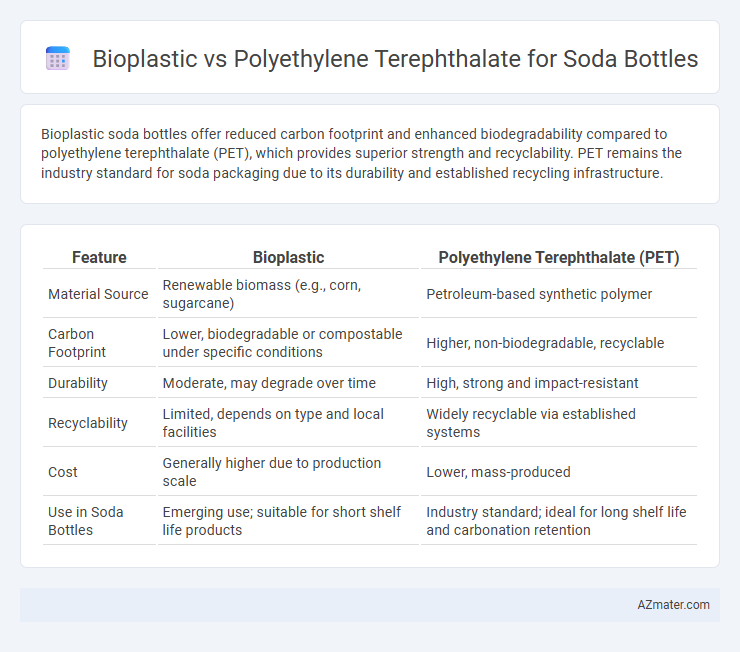Bioplastic soda bottles offer reduced carbon footprint and enhanced biodegradability compared to polyethylene terephthalate (PET), which provides superior strength and recyclability. PET remains the industry standard for soda packaging due to its durability and established recycling infrastructure.
Table of Comparison
| Feature | Bioplastic | Polyethylene Terephthalate (PET) |
|---|---|---|
| Material Source | Renewable biomass (e.g., corn, sugarcane) | Petroleum-based synthetic polymer |
| Carbon Footprint | Lower, biodegradable or compostable under specific conditions | Higher, non-biodegradable, recyclable |
| Durability | Moderate, may degrade over time | High, strong and impact-resistant |
| Recyclability | Limited, depends on type and local facilities | Widely recyclable via established systems |
| Cost | Generally higher due to production scale | Lower, mass-produced |
| Use in Soda Bottles | Emerging use; suitable for short shelf life products | Industry standard; ideal for long shelf life and carbonation retention |
Introduction to Soda Bottle Packaging Materials
Soda bottle packaging materials predominantly include bioplastic and polyethylene terephthalate (PET), each offering unique properties suited for beverage containment. Bioplastics, derived from renewable biomass sources such as corn starch or sugarcane, provide enhanced biodegradability and reduced carbon footprint compared to conventional plastics. In contrast, PET, a petroleum-based polymer, remains the industry standard due to its excellent strength, clarity, and recyclability, ensuring product safety and extended shelf life.
What is Bioplastic?
Bioplastic is a type of plastic derived from renewable biomass sources such as corn starch, sugarcane, or cellulose, offering a more sustainable alternative to traditional petroleum-based plastics like polyethylene terephthalate (PET). Unlike PET, which is synthesized from fossil fuels and widely used in soda bottles for its strength and clarity, bioplastics aim to reduce carbon footprint and environmental pollution. Despite bioplastic's potential for biodegradability and lower greenhouse gas emissions, its performance and cost-effectiveness compared to PET are critical factors in commercial soda bottle production decisions.
Understanding Polyethylene Terephthalate (PET)
Polyethylene terephthalate (PET) is a widely used thermoplastic polymer in soda bottle manufacturing due to its excellent strength, lightweight nature, and clarity. PET offers high gas barrier properties, effectively preserving carbonation and extending shelf life of beverages. Its recyclability and established global recycling infrastructure make PET a sustainable choice compared to many bioplastics currently lacking efficient end-of-life processing.
Environmental Impact: Bioplastic vs PET
Bioplastic soda bottles reduce carbon emissions by using renewable plant-based materials, significantly lowering reliance on fossil fuels compared to polyethylene terephthalate (PET), which originates from non-renewable petroleum. Bioplastics also offer enhanced biodegradability and compostability under industrial conditions, whereas PET persists in the environment for hundreds of years, contributing to plastic pollution and microplastic formation. However, bioplastic production can compete with food resources and sometimes requires industrial composting facilities, limiting its environmental benefits relative to the widely recyclable PET bottles.
Biodegradability and Recycling Comparisons
Bioplastic soda bottles offer enhanced biodegradability compared to polyethylene terephthalate (PET), breaking down more quickly under industrial composting conditions, thereby reducing long-term environmental impact. PET bottles dominate recycling systems with established infrastructure, allowing efficient material recovery and high-value reuse in new products. However, the biodegradability advantage of bioplastics is often limited by contamination risks and less developed recycling processes, posing challenges for large-scale circular economy integration.
Barrier Properties and Shelf Life
Bioplastic soda bottles, particularly those made from polylactic acid (PLA), generally have inferior barrier properties compared to polyethylene terephthalate (PET), with higher oxygen and moisture permeability leading to shorter shelf life for carbonated beverages. PET exhibits excellent gas barrier performance, maintaining carbonation and flavor integrity for up to 6 months or more under typical storage conditions. Advances in bioplastic composites and coatings are ongoing to close the gap, but PET remains the industry standard due to its superior barrier properties and extended shelf life for soda packaging.
Cost Analysis and Market Availability
Bioplastic soda bottles generally have higher production costs compared to polyethylene terephthalate (PET) due to raw material expenses and limited large-scale manufacturing infrastructure. PET remains the dominant choice in the soda industry, with extensive market availability supported by established recycling systems and supply chains. Cost efficiency and widespread access make PET more attractive for mass production, while bioplastics are gaining traction in niche markets emphasizing sustainability.
Consumer Perception and Branding
Consumer perception of bioplastic soda bottles often centers on sustainability, with many viewing them as eco-friendly alternatives to polyethylene terephthalate (PET) bottles, which are commonly criticized for environmental impact despite their recyclability. Brands leverage bioplastic materials to enhance green branding strategies, appealing to environmentally conscious consumers and aligning products with corporate social responsibility goals. PET bottles maintain strong brand recognition due to their clarity, durability, and cost-effectiveness, but bioplastic usage can differentiate products in competitive markets by emphasizing innovation and reduced carbon footprint.
Regulatory Standards and Safety Concerns
Bioplastic soda bottles are often subject to stringent regulatory standards such as FDA and EFSA approvals, ensuring they meet safety criteria for food contact materials, including non-toxicity and biodegradability requirements. Polyethylene terephthalate (PET) bottles comply with extensive global regulations like FDA 21 CFR 177.1630 and EU Regulation No. 10/2011, guaranteeing chemical stability and preventing contamination in carbonated beverage packaging. Safety concerns for bioplastics primarily involve the potential migration of additives and the transformation behavior under various storage conditions, while PET's industrial-scale use provides a well-documented safety profile and recyclability standards.
Future Trends in Soda Bottle Packaging
Bioplastic soda bottles are gaining traction due to their biodegradability and reduced carbon footprint, addressing increasing consumer demand for sustainable packaging solutions. Polyethylene terephthalate (PET) remains dominant because of its superior durability, recyclability, and cost-effectiveness, but innovations like bio-PET are merging bioplastic benefits with PET's performance. Future trends suggest a hybrid approach combining biobased content in PET to enhance environmental impact without compromising functionality in soda bottle packaging.

Infographic: Bioplastic vs Polyethylene terephthalate for Soda bottle
 azmater.com
azmater.com